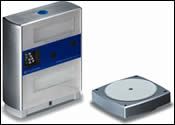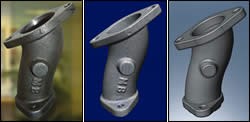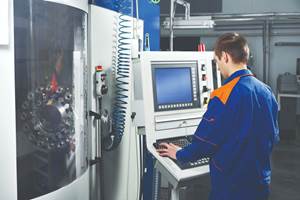Desktop 3D Scanner Captures Part Shapes
This desktop laser scanning system allows 3D objects to be digitized so that the data can be used to create part geometry for tool path generation. The system's ease of use and low cost make reverse engineering available to machine shops that could not previously access this technology.
Scan it. Cut it. That’s the approach many shops would like to take. A new desktop laser scanning system promises to make that a practical reality at low cost. The system allows 3D objects to be digitized so that surface data can be used to create part geometry for toolpath generation. The NextEngine Desktop 3D Scanner from NextEngine Inc. (Santa Monica, California) uses a set of laser “eyes,” digital camera technology and image sensors to capture scan data from multiple, triangulated views. The system’s special software assembles and manipulates the data to create a 3D model suitable for use in a CAM system.
Scanning systems for reverse engineering have been available for years. What sets this new system apart from existing systems is that it is priced and packaged like a consumer electronics product. The hardware consists of a scanning unit (about the size of a cereal box) and a turntable that automates part positioning for scanning. The user interface software, ScanStudio Core, operates the scanner and the turntable. It is priced at $2,495. Two software options, ScanStudio Pro and RapidWorks, provide further capabilities and are priced in the same range.
For the machine shop, desktop scanning is a benefit when the machining process starts with a part—a prototype, a pattern, a model or a free-form “organic” shape carved in the studio or found in nature. CNC machines are designed to produce parts as the end product. The physical object cut from metal is the output. But CNC machines also require input, the numerical part program that gives the proper commands. Digital laser scanning helps bridge the gap from “start part” to end part by providing the “art” (shape geometry) in the middle. According to developers, the desktop scanner makes 3D scanning technology available to virtually any machine shop.
The scanning unit uses arrays of low-power lasers that sweep across an object while 3-megapixel cameras capture scanned data. Multiple sweeps and multiple positionings of the object are usually required to gather a complete 3D scan. The various passes can be displayed and merged in the PC software. Objects with matte white surfaces are easiest to scan; objects with shiny black surfaces are more difficult. The latter may require a powder dusting to reduce reflectiveness.
Objects the size of a soda can or smaller can be scanned in the “macro mode,” while objects as large as a shoebox can be scanned in the “wide mode.” The roundtable can be used to index smaller objects automatically for multiple scans. Large objects may have to be repositioned by hand. Developers say that, theoretically, there is no limit to the size of the object because any number of scans can be stitched together. Parts fitting within the "wide mode" can be scanned and aligned with one click. Scans from larger parts are semi-automatically aligned with “virtual beads” that the software can use to locate and connect common points in the scanned data for merging. Regardless of the merging process, blending and trimming overlaps is automated, thus speeding what might otherwise be a tedious process.
Scan data can be used to create file formats in three categories—mesh, surface and solid—that correspond to the level of software acquired by the user. For example, the standard software that comes with the system is adequate for STL formats that can be exported to a CAM system for basic machining. Most shops will be interested in the surface or solid file capabilities because they provide geometry comparable to the models shops often use as input to CAM.
Related Content
When Handing Down the Family Machine Shop is as Complex as a Swiss-Turned Part
The transition into Swiss-type machining at Deking Screw Products required more than just a shift in production operations. It required a new mindset and a new way of running the family-owned business. Hardest of all, it required that one generation let go, and allow a new one to step in.
Read MoreKey CNC Concept No. 1—The Fundamentals Of Computer Numerical Control
Though the thrust of this presentation is to teach you CNC usage, it helps to understand why these sophisticated machines are so important. Here are but a few of the more important benefits offered by CNC equipment.
Read MoreHow this Job Shop Grew Capacity Without Expanding Footprint
This shop relies on digital solutions to grow their manufacturing business. With this approach, W.A. Pfeiffer has achieved seamless end-to-end connectivity, shorter lead times and increased throughput.
Read MoreUnderstanding CNC Machine Accuracy and Repeatability
Properly evaluating machine tool capability requires understanding how the both user and the builder can influence precision.
Read MoreRead Next
The Cut Scene: The Finer Details of Large-Format Machining
Small details and features can have an outsized impact on large parts, such as Barbco’s collapsible utility drill head.
Read More3 Mistakes That Cause CNC Programs to Fail
Despite enhancements to manufacturing technology, there are still issues today that can cause programs to fail. These failures can cause lost time, scrapped parts, damaged machines and even injured operators.
Read More
















.png;maxWidth=300;quality=90)

.png;maxWidth=300;quality=90)









